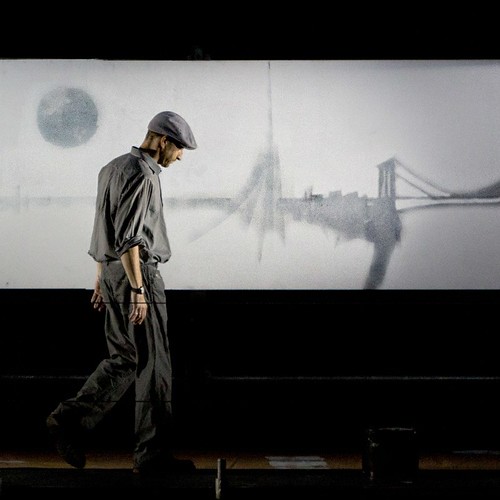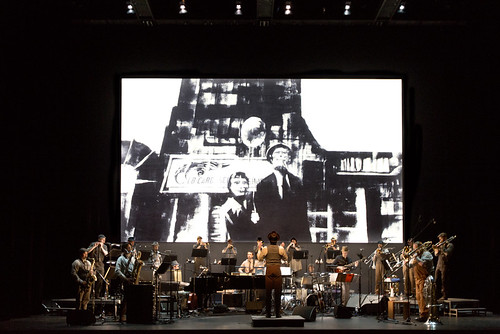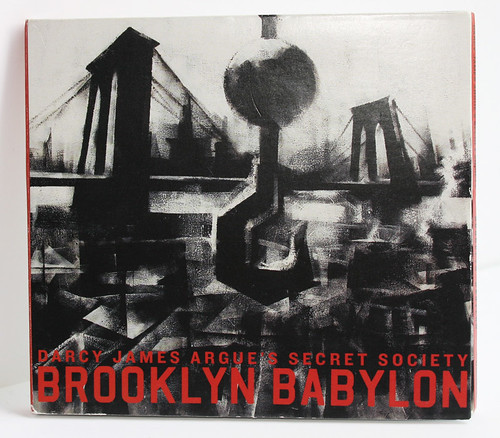Friday, 12:30pm
12 July 2013
Babylon aan ’t IJ
Brooklyn Babylon, a multimedia spectacular by Darcy James Argue and Danijel Žeželj, raises the roof at the Holland Festival

In the critic’s lexicon, there are few terms more problematic than ‘multimedia’, writes John L. Walters.
The term can point to anything from grand opera to gallery exhibitions with broken headphones dangling forlornly from monitors – it can be used to wave vaguely in the direction of a hundred aesthetic sins.
So it is a pleasure (and relief) to report that Brooklyn Babylon, the collaboration between Canadian composer Darcy James Argue and Croatian artist Danijel Žeželj, was a triumph.
Brooklyn Babylon trailer on Vimeo.
Top: photography by Ada Nieuwendijk.
The recent performance at Amsterdam’s Muziekgebouw aan ’t IJ on the penultimate night of the Holland Festival was only the second performance of this ambitious work, which involves an eighteen-piece orchestra, projected animations and real-time painting. The musicians – Argue’s Grammy-winning band Secret Society – are in the costume of 1900s blue-collar workers, with hats and overalls.
Sometimes they play off-stage, or walk through the auditorium, and Argue conducts the opening section from a high balcony. Yet there’s no sense that any aspect of this complex music is compromised by the staging.
Danijel Žeželj on stage. Photo: Ada Nieuwendijk.
Žeželj, whose wordless graphic fable Babilon gives the work its mood and structure, participated by painting live during the performance on a narrow horizontal canvas erected behind the stage, while his animations play on a screen that descends for each of the work’s eight main sections.
The audience could witness the progress of Žeželj’s painting during the seven interludes and the opening Prologue. The flat-capped painter worked steadily in black and red paint using brushes and a variety of rollers, some of which had patterned surfaces. (A live video camera also projected Žeželj’s mark-making in close-up.)
The resulting painting-in-progress was a sharply defined cityscape that showed people and places from the Brooklyn Babylon story – craftsman Lev, his grand-daughter and the giant Tower of Brooklyn, a metaphor for the insensitive ambitions of city mayors and developers everywhere.
Žeželj’s animated image of Lev and his grand-daughter projected above the eighteen-piece Secret Society (plus DJA).
Photo: Ada Nieuwendijk.
Video from Brooklyn Babylon producers Beth Morrison Projects.
Five minutes before the end, as the Secret Society launched into Brooklyn Babylon’s magnificent and grandiose Epilogue, Žeželj had a further dramatic surprise in store. Starting at the far right of his canvas, he steadily painted out the completed image using a roller loaded with thick black paint.
The Secret Society take a bow in front of Žeželj’s obliterated skyline. Photo: John L. Walters.
So by the time the Amsterdam audience members had leapt to their feet to applaud this visceral, multilayered and hugely rewarding work, Žeželj’s artwork was gone, its details as evanescent as the notes that had filled the air of the concert hall. But both sound and image will live on in our collective memories of this dynamite performance.
Album cover for Darcy James Argue’s Secret Society Brooklyn Babylon featuring artwork by Daniel Žeželj.
You can get a taste of Brooklyn Babylon on Argue’s album (which I reviewed for LondonJazz) on New Amsterdam Records, and in Žeželj’s wordless novel Babilon (Petikat, 2013).
Spread from Babilon (Petikat), a wordless graphic novel by Daniel Žeželj.
Neither fully prepares one for the impact of this multimedia magnum opus. Let’s hope that adventurous festival programmers and concert promoters worldwide find the courage (and wherewithal) to give Brooklyn Babylon a home on their stages.
Brooklyn Babylon was performed at Bimhuis / Muziekgebouw aan ’t IJ on Monday 24 June as part of the Holland Festival.
Brooklyn Babylon credits.
Jim Findlay
: video design
Isaac Butler
: consulting director
Paloma Young
: costumes
Scott Bolman: lighting design
Beth Morrison Projects: creative producer
Commissioned by Brooklyn Academy of Music for the Next Wave Festival
John L. Walters, music writer and Eye editor.
Eye is the world’s most beautiful and collectable graphic design journal, published quarterly for professional designers, students and anyone interested in critical, informed writing about graphic design and visual culture. It is available from all good design bookshops and online at the Eye shop, where you can buy subscriptions, back issues and single copies of the latest issue.





